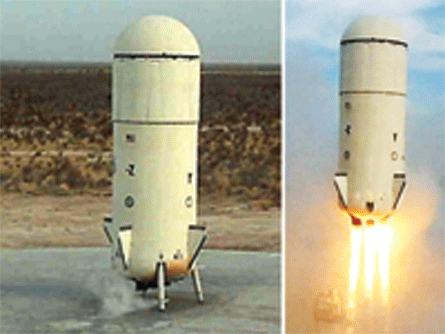Many of the so-called "new space" commercial spaceflight companies are actually private corporations bankrolled by multi-billionaires - and are thus under no particular obligation to reveal programme milestones or disclose major events. Following the software industry's lead, commercial spaceflight companies are also often intensely secretive.
One of the most disclosure-shy of the major players is Blue Origin - a company set up by online shopping giant Amazon.com founder Jeff Bezos. However, recent events have forced the company to be more open.
The 24 August in-flight destruction of the New Shepard rocket - Blue Origin's suborbital booster - took place after what Blue Origin called "a flight instability", resulting in "an angle of attack that triggered our range safety system to terminate thrust on the vehicle".
Booster break-up
Media reports, citing eyewitness accounts and social media postings, indicate an explosion at high altitude. It is unclear whether the explosion was directly caused by a malfunction, purposely triggered by the range safety system or a result of vehicle break-up due to aerodynamic forces.
The company released a short statement on its website, signed by Bezos - the first official programme update in five years.
According to Bezos's statement, the spacecraft made it to 45,029ft (13,725m) and mach 1.2 before the malfunction. Accompanying the statement were two pictures of the New Shepard in a configuration never before seen in public.
The ill-fated flight - apparently a test of the booster system - took place without a payload.
 |
|---|
The New Shepard is designed to launch suborbital payloads including human-rated capsules |
Advance notice of the test was limited. A NOTAM issued by the US Federal Aviation Administration closed the airspace above the Culberson County, Texas, launch site to all visual flight rules (VFR) aircraft. As VFR aircraft are only allowed up to altitudes of 18,000ft, the NOTAM gave no indication of the test's nature.
Previous publically-acknowledged tests have been limited to low-altitude flights of the company's Goddard rocket testbed - those tests were only revealed months after they occurred. At least one flight, limited to 10,006ft, was revealed by a NOTAM earlier in 2011.
New Shepard is designed to launch suborbital payloads - including human-rated capsules - to an altitude of 325,213ft before separating, allowing the payload to continue climbing while the booster returns. The booster then fires its engines again, slowing to execute a vertical landing.
The public has only seen tantalizing hints of Blue Origin's intentions. A patent application entitled "sea landing of space launch vehicles and associated systems and methods", dated 27 January 2011, describes the booster.
The document also includes a tiny sketch of the New Shepard in its current configuration.
Meanwhile, another unnamed space company is in talks to lease land on the Texas coast, just north of Galveston.
A spacecraft launched east from Texas would get a significant boost from the Earth's rotation, allowing greater velocity for a payload to be launched. This is why NASA's Kennedy Space Center is located on the US East Coast.
Mystery company
While speculation as to the company's identity has been rife - Elon Musk's SpaceX being a particularly strong contender - the known descriptions of a capsule may also fit Blue Origin.
Another patent application, dated 30 December 2010 and entitled "bidirectional control surfaces for use with high-speed vehicles and associated systems and methods", provided more information.
Sketches of the booster - enclosed as part of the application - showed a vehicle virtually identical to the one lost on 24 August.
The designs feature a single-stage vehicle with five engines - indicating a liquid fuel system.
Blue Origin is also participating in NASA's commercial crew development (CCDev) program, a three-round series of grants designed to accelerate the development of certain technologies.
Only two rounds have been awarded so far, and Blue Origin has won both.
The first, CCDev1, saw NASA award $3.7 million to accelerate development of Blue Origin's "pusher" launch abort system - a separate series of rockets attached to a tower atop the spacecraft.
For CCDev2, Blue Origin was awarded $22 million to help develop a biconic manned orbital capsule, which will be launched by an Atlas V rocket.
The New Shepard booster itself did not receive CCDev funds, and is therefore exempt from public disclosure laws.
The company is also not required to inform NASA of what took place on 24 August - and so far the agency has not officially requested the information.
Source: Flight International


























